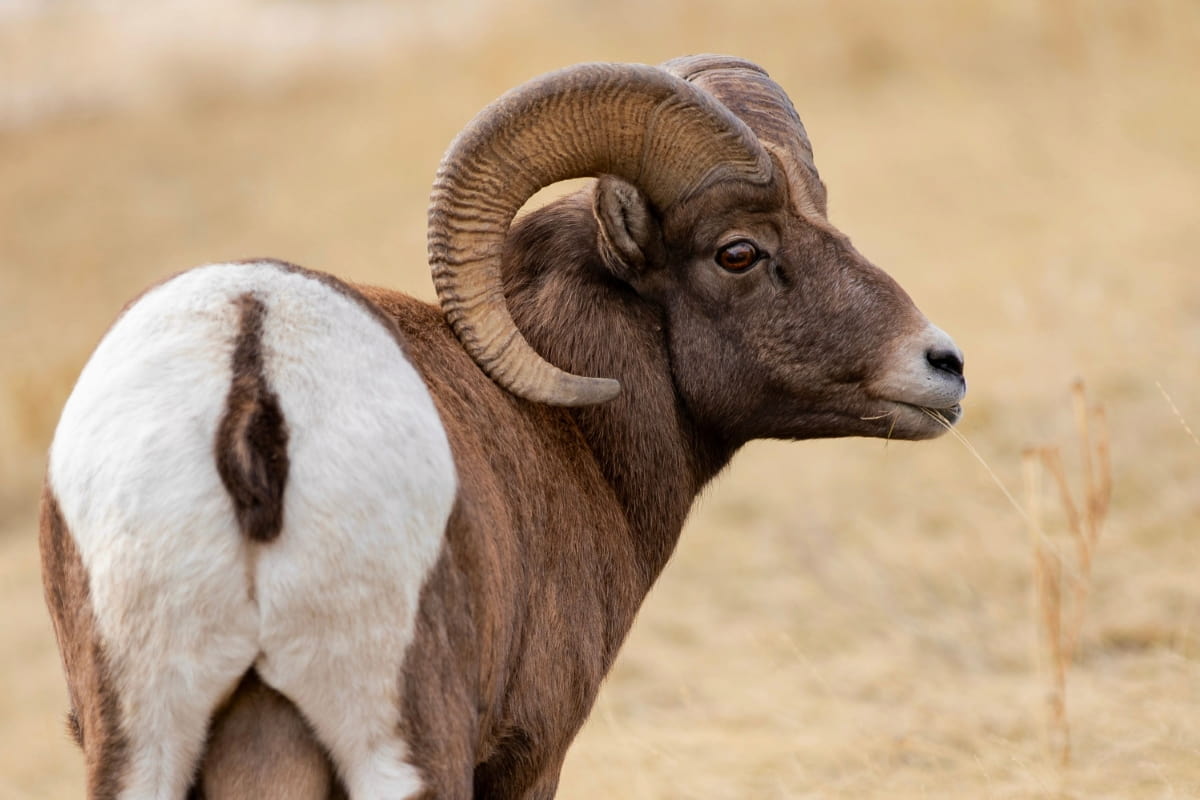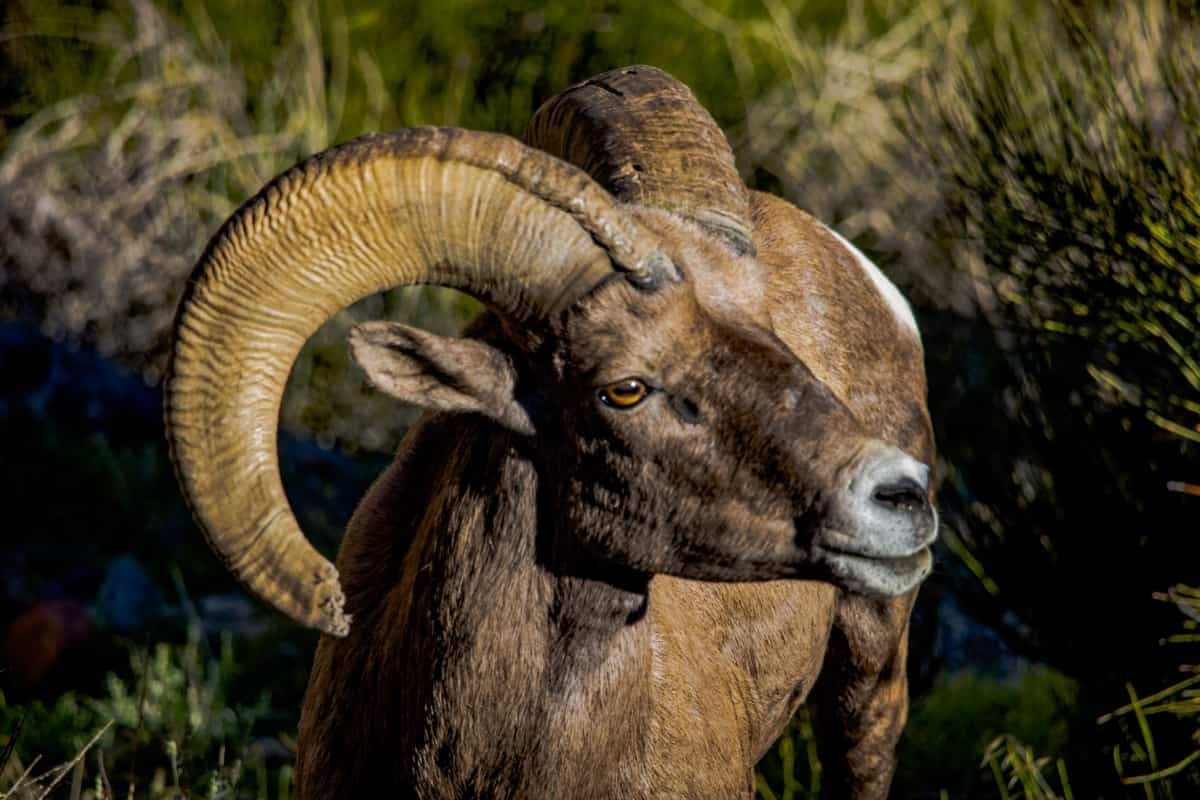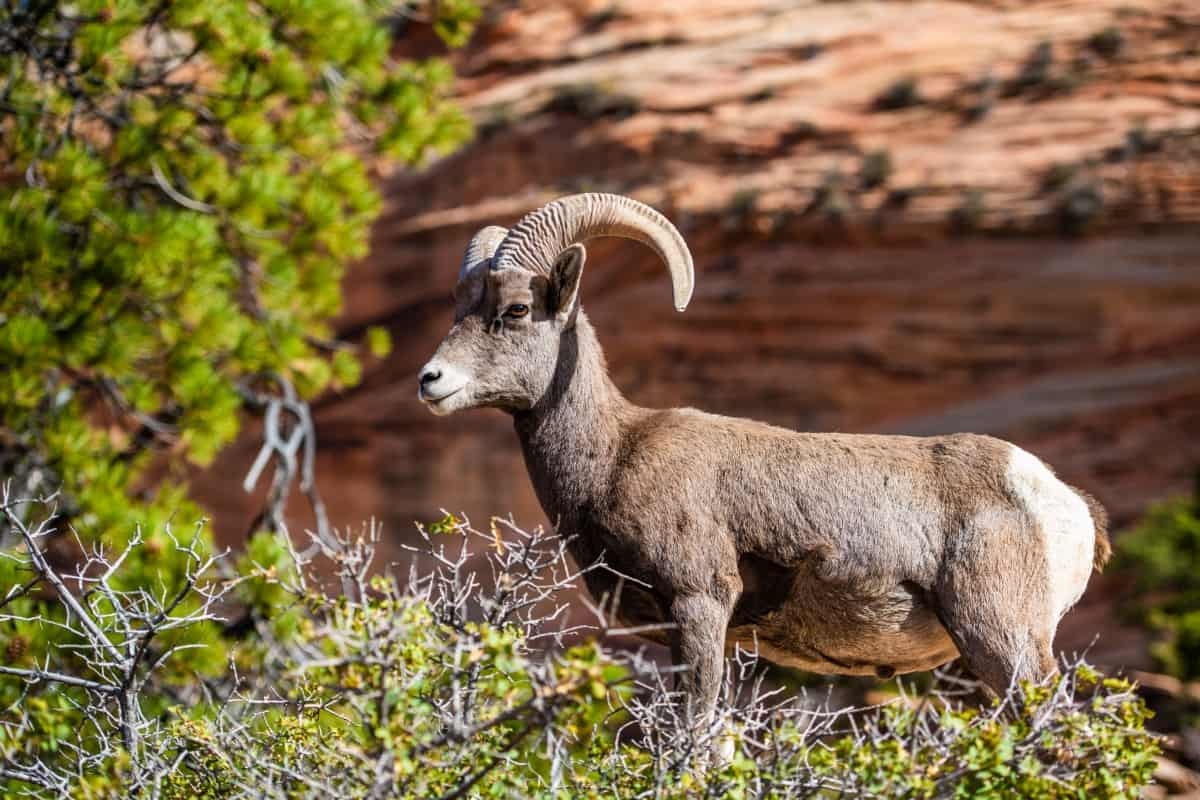Bighorn sheep, with their majestic horns and remarkable agility, are emblematic of the rugged terrains of North America. Revered for their resilience and strength, these animals hold a significant place not only in the ecosystem for their role in maintaining ecological balance but also in cultural lore, symbolising rugged wilderness and freedom. Their ability to navigate cliffs and dramatic mating rituals make them a fascinating subject of scientific study and public interest, underscoring the need for their conservation.

Bighorn Sheep
Distribution and Habitat
Bighorn sheep are predominantly found in the western mountainous regions of North America, ranging from Canada’s cold, snowy peaks down through the western United States and into the deserts of Mexico. They adapt to various habitats, from alpine meadows and grassy mountain slopes to rocky, arid deserts, showcasing their incredible versatility. Their habitat preferences are closely tied to the availability of steep, rugged terrain for escape from predators and access to food and water sources.
Bighorn Sheep Lifespan
The lifespan of bighorn sheep in the wild typically ranges from 10 to 15 years, though some individuals may live longer under optimal conditions. Factors influencing their longevity include predation, disease, and habitat quality. In protected areas and under ideal circumstances, bighorn sheep have been known to reach up to 20 years of age, highlighting the impact of environmental conditions and conservation efforts on their survival.
Bighorn Sheep Physical Characteristics
Size and Appearance
Bighorn sheep are distinguished by their significant size and muscular build, with adult rams typically weighing 140 to 300 pounds and standing around 3 to 3.5 feet tall at the shoulder. Ewes are slightly smaller, contributing to the bighorn sheep female vs male distinction. Their coats vary in colour from light brown to greyish, with white patches on the rump, muzzle, and back of the legs. The most striking feature of bighorn sheep is their large, spiralled horns, which can weigh up to 30 pounds in rams, representing a significant portion of their body weight.
Unique Features of Rams and Ewes
The primary distinction between rams and ewes lies in their horns; rams boast large, curved horns used in mating rituals and as a defence mechanism, while ewes have shorter, less curved horns. The distinction in physical features between these animals is significant, influencing their behavior and social hierarchy, particularly during mating season when rams compete in head-to-head conflicts for dominance and mating privileges.
Behaviour and Social Structure
Herd Dynamics
Bighorn sheep are social animals, typically found in separate herds based on gender. Ewes, lambs, and young rams form nursery herds, which provide safety in numbers, while mature rams often form smaller bands or live solitarily except during the mating season. The herd dynamics of bighorn sheep are complex, with a clear hierarchy established through displays of dominance and submission, ensuring social stability within the group.
Mating Rituals and Season
The mating season, or rut, is a critical time for bighorn sheep, characterised by dramatic displays of strength and endurance. Rams engage in fierce competitions, including charging each other at speeds of up to 20 miles per hour, to win the right to mate with ewes. These rituals determine reproductive success and reinforce the rams’ social hierarchy.
Diet and Foraging Habits
Preferred Foods and Foraging Behavior
Bighorn sheep are herbivores with a diet of grasses, forbs, and shrubs. Their foraging behaviour is adapted to the seasonal availability of food, with a preference for fresh, nutrient-rich plants. They are known to travel great distances to find suitable feeding grounds, reflecting their adaptability and resilience in changing environmental conditions.
Seasonal Diet Variations
The diet of bighorn sheep varies seasonally, with a shift towards different types of vegetation depending on the time of year. In spring and summer, they feed on various green plants; in fall and winter, they rely more on woody plants and dry grasses. This flexibility in the diet allows them to survive in the diverse and often harsh habitats they occupy.
In case you missed it: Zwartbles Sheep: Raising Facts, Profile, Characteristics, Uses, and Care

Habitat and Range
Native Habitats and Ecosystems
Bighorn sheep inhabit various ecosystems, from mountainous terrains and rocky slopes to desert areas, showcasing their remarkable adaptability. Their native habitats are characterised by cliffs and rugged outcrops, providing the necessary food sources and protection from predators. The specific terrain of bighorn sheep habitat plays a crucial role in their behaviour, especially their ability to navigate and escape threats.
Current Range and Population Distribution
The current range of bighorn sheep extends from the western United States into Canada and northern Mexico, although their populations are fragmented and vary widely in size. Conservation efforts focus on protecting and connecting these habitats to support genetic diversity and population growth. Despite challenges, bighorn sheep conservation has seen successes, with several areas reporting stable or increasing populations, thanks to dedicated research, habitat restoration, and protection measures against diseases and human encroachment.
Conservation Status
Threats to Survival
Bighorn sheep face numerous threats that challenge their survival, including habitat loss due to urbanisation, competition for food with domestic livestock, diseases transmitted by domestic animals, and climate change. Predation by mountain lions, wolves, and bears also poses a natural threat, although human activities have exacerbated many challenges. Monitoring and mitigating these threats is crucial for conserving bighorn sheep populations.
Conservation Efforts and Success Stories
Conservation efforts for bighorn sheep include habitat restoration, wildlife corridors to connect fragmented populations, and programs to reduce disease transmission from domestic animals. Successful conservation stories often involve collaborative projects between wildlife agencies, conservation organisations, and local communities, leading to the stabilisation and even growth of certain bighorn sheep populations. These successes highlight the importance of targeted conservation strategies and ongoing research to ensure the long-term survival of bighorn sheep.
Breeding and Lifecycle
Reproduction Cycle
The reproduction cycle of bighorn sheep begins in the late fall when rams compete for mating rights during the rut. Ewes typically give birth to one lamb after a six-month gestation period, usually in late spring, which allows lambs to take advantage of the availability of fresh vegetation. This timing is crucial for the survival and growth of the young lambs.
Growth and Development of Lambs
Lambs are born precocious and can stand and walk within hours of birth. They rely on their mothers for milk in the early weeks but soon begin to graze on vegetation. The growth and development of lambs are rapid, with weaning occurring around 4-6 months. During this time, lambs learn essential survival skills, including navigating steep terrain and evading predators, under the guidance of their mothers and the herd.
Human Interactions and Impact
Historical Significance to Indigenous Cultures
Bighorn sheep hold significant historical and cultural importance to many indigenous cultures across North America. They have been a source of sustenance, and their images are found in ancient petroglyphs and artefacts, symbolising strength, agility, and resilience. The reverence for bighorn sheep in these cultures underscores the deep connection between humans and wildlife and the importance of preserving these relationships.
Effects of Urbanization and Recreation
Urbanisation and recreational activities in natural habitats pose significant challenges to bighorn sheep populations. The fragmentation of habitats by roads and developments limits their range and access to traditional feeding and breeding grounds. Engaging in recreational pursuits like hiking and off-road vehicle usage can disrupt the natural behaviors of wildlife, leading to heightened stress levels and adverse effects on their overall welfare and survival.
In case you missed it: Ultimate Guide to Raising Lonk Sheep: Facts, Profile, Characteristics, Uses, and Care

Bighorn Sheep Female vs Male
The differences between female (ewe) and male (ram) bighorn sheep are most notable in their size and horn structure. Rams have larger, more massive horns that curl in a full spiral, while ewes have shorter, less curved horns. These physical distinctions are complemented by behavioural differences, particularly during breeding when rams engage in head-butting contests to establish dominance and gain mating opportunities.
Bighorn Sheep vs Mountain Goat
While bighorn sheep and mountain goats share similar rugged mountain habitats, they are distinct species with different adaptations and behaviours. Bighorn sheep are typically larger and prefer drier, rocky slopes, while mountain goats are adapted to wetter, more vertical environments. The two species also differ in their social structure, diet, and physical characteristics, such as the shape of their horns and the texture of their coats, making each uniquely suited to their specific ecological niches.
In case you missed it: Ultimate Guide to Raising Ile De France Sheep: Farming Facts, Breed Profile, Uses, and Care

Conclusion
Bighorn sheep are remarkable creatures symbolizing North American wilderness’s rugged beauty and complexity, facing various threats yet persevering through concerted conservation efforts.
Note: The images presented in this post are intended solely for representation purposes. The images are meant to serve as visual aids and should not be relied upon as accurate representations of their real-life counterparts.
- Feed Your Flock for Less: Top 10 Tips to Save on Chicken Feed
- Ultimate Guide to Ossabaw Island Hog: Breeding, Raising, Diet, and Care
- Hatching Answers: The Top 10 Reasons Your Chickens Aren’t Laying Eggs
- Eggs and Economics: Breaking Down the Cost of Raising Backyard Chickens
- Defend Your Greens: Proven Methods to Keep Iguanas Out of Your Garden
- Ultimate Guide to Cinnamon Queen Chicken: A Comprehensive Guide for Beginners
- Ultimate Guide to California Tan Chicken: Breeding, Raising, Diet, Egg-Production and Care
- Ultimate Guide to Marsh Daisy Chicken: Breeding, Raising, Diet, and Care
- 10 Types of Chicken Farming Businesses You Can Start for Profits